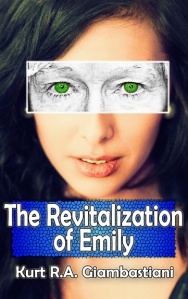 We are live. “The Revitalization of Emily” is live on Amazon, and available for Kindle readers and apps.
We are live. “The Revitalization of Emily” is live on Amazon, and available for Kindle readers and apps.
Formatting went well, but there’s one new lesson I learned. Fonts that work well on the printed page are often too big for the Kindles. I had a couple of iterations before the headers worked properly.
Overall, though, an easy process.
Some people wonder why I do this on Kindle Direct Publishing (KDP) instead of iBooks or Smashwords or any of the several other venues open to short fiction works. They also wonder why I don’t put it up everywhere, simultaneously.
The main reason is one word: reach.
Amazon is by far the leader in this medium. The Kindle devices dominate the e-reader market, bowling over the Japanese-based e-readers of Sony and Samsung. Kindle isn’t favored as a tablet (Apple wins that one, hands down), but with the Kindle app for Windows and iOS, they have a strong share of tablet users buying from them as well.
Match up Amazon’s device and application platform to its retail footprint, and it’s a behemoth that is available to everyone with a computer, tablet, or smart phone. That, my friends, is reach.
Another reason is integration. All my novels–hardcopy and e-book–are on Amazon and I want customers to be able to move easily from one title to the next. Yes, other venues have my books, too, but not all of them, and not at as good a price. However, reformatting the work for each venue takes time, and provides diminishing returns when working for these smaller players.
Amazon, KDP, and CreateSpace (hardcopy printer) are now tied so closely that I can build a hardcopy book and an e-version that can sell as a bundle on Amazon at a discounted price. It’s a way of “upselling” my product with an add-on feature.
My other reasons for working with Amazon/KDP include the ease of use (very easy and, the control I have over pricing and royalties (and the royalties are more generous at KDP). In addition, if I make my e-book exclusive to KDP, there are extra benefits: Amazon Prime members can buy my book for free (I still get royalties), and users can lend the books to other Kindle users (and they do) which helps spread the word. Their services are also generally free-of-charge. Even CreateSpace hardcopy publishing is more cost-effective.
Some people hate Amazon because they’re big. They are, and they’re changing the face of publishing, which also makes some folks nervous. But hating them because they’re big means hating them because they’re successful, because they’re good at what they do.
For my money, they’re the best venue for my indie works, and they provide me the best advantage. That’s a no-brainer.
k
 Unraveling Time
Unraveling Time Desert Wind
Desert Wind Ploughman's Son
Ploughman's Son Ploughman King
Ploughman King The Year the Cloud Fell
The Year the Cloud Fell The Spirit of Thunder
The Spirit of Thunder Shadow of the Storm
Shadow of the Storm The Cry of the Wind
The Cry of the Wind Beneath a Wounded Sky
Beneath a Wounded Sky Cryptogenesis: A Memoir
Cryptogenesis: A Memoir
Hi Kurt
I’m looking for the new story you mentioned ??
reagrds
Ashley (UK)
LikeLike
Hey, Ashley! Thanks for dropping by.
The new story “Antelope Hunting with Sir John” begins here:
The story is in 4 parts.
LikeLike
I take it that means there will never be versions for my Nook?
LikeLike
Sorry. I suppose there isn’t a kindle app for nook?
LikeLike
Looks like you _can_ download the Kindle app (Android version) for your Nook.
LikeLike
I’ll take a look. Thanks! I’m pretty much having to switch to digital books, (gradually replacing my essential library and discarding the paper editions), and they’re all B&N or DRM free.
LikeLike
As the markets for e-readers and e-books diverge, I see more readers open up to non-invested marketers. iPad is probably the most open (unexpectedly). I can run iBooks, Kindle, and Nook on it. The Nook has at least Nook and kindle. My wife’s Kindle Fire, though, does not support the Nook app.
LikeLike